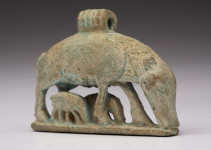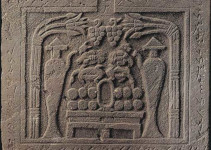Exhibitions
Departments
An altar in the savannah
In the early 3rd century the rulers of Napata moved their capital and the necropolis with royal pyramids to Meroe, situated in the fertile territories of Al-Butana. This date marks the beginning of a new era in the history of the ancient Kush kingdom. The Altar of the Sun was said to be located near the city and there every day huge offerings of food were presented to the gods. The ruler (gore) was elected from among the male relatives of the dead predecessor and his power was supported by a strong army and the priests whose oracle had to sanction the candidacy. The region between the 2nd Cataract and the border with Hellenistic and then Roman Egypt enjoyed some autonomy and was administered by viceroy called pesto.
Between Africa and the Mediterranean world
The mysterious land on the southern edges of the known world attracted the attention of many ancient writers. Already Herodotus wrote down some reports about Meroe during his stay on Elephantine, while the geographic descriptions of Central Sudan in Diodorus Siculus, Strabo and Pliny appear to be even more detailed. The magnificent bronze head of a Roman statue discovered in the ruins of a building in Meroe could have been a war booty following the armed conflict of 25 – 21 BC between the prefect of Egypt Gaius Petronius and the invading Meroitic army under the queen kandake. We know also that on Emperor Nero’s orders limited (and unsuccessful) military expeditions were undertaken to discover the sources of the Nile. The influence of the Greco-Roman culture is evidenced by numerous luxurious articles from the Empire found in Meroitic graves as well as the Greek alphabet carved out on a column in the city of Meroe – a proof of Greek teaching (king Ergamenes, identified with Arkamani, is said to have had classical education).
Undeciphered script and mysterious language
Among many languages and dialects that in the ancient times were spoken by the inhabitants of the kingdom of Kush, only Meroitic came to be written down. Although now we are able to assign particular phonetic values to some of the signs, the language itself remains largely undeciphered and only the meanings of a few words have been determined.
In the 2nd century BC, a special alphabet based on 23 hieroglyphics drawn from the Egyptian tradition started to be used in royal inscriptions. Two centuries later there spread a new script, commonly called the cursive, which developed from the combination of graphically simplified hieroglyphics with 4 signs of Egyptian demotic script. The cursive was mainly used for general records and correspondence, and on private funerary steles and sacrificial altars. Ancient authors claimed that the ability to read and write was much more common among the Meroeans than among the Egyptians.
Gods of Egypt and gods of Meroe
The centuries of pharaonic rule in Lower Nubia left behind a permanent trace in the form of the Egyptian religion, whose zealous disciples were the rulers and the elite of the Meroitic society. The main god of Meroe was Amon (in Meroitic Amani), closely linked with the ideology of the royal power, worshipped in numerous temples, e.g. in Napata, Naga and the capital itself. The worship of goddess Isis from the island of Philae in Lower Nubia also seems to have been popular. Among the domestic Kush pantheon, the lion-headed Apademak was of particular importance, with sanctuaries in Naga and Mussawarrat es-Sufra.
Meroitic funerary rites were also strongly influenced by the Egyptian tradition. Graves were equipped with steles, originally shaped statuettes of the soul Ba and stone sacrificial altars, while the splendour of gifts placed in the pyramids of Meroe’s ruler equalled that in the pyramids of the contemporary pharaohs. Ritual human sacrifice and the tradition of placing corpses on wooden beds seem to be a relict of old Nubian customs.
Nasza strona internetowa używa plików cookies (tzw. ciasteczka) w celach statystycznych, reklamowych oraz funkcjonalnych. Dzięki nim możemy indywidualnie dostosować stronę do twoich potrzeb. Każdy może zaakceptować pliki cookies albo ma możliwość wyłączenia ich w przeglądarce, dzięki czemu nie będą zbierane żadne informacje. Dowiedz się więcej jak je wyłączyć. OK, Rozumiem






